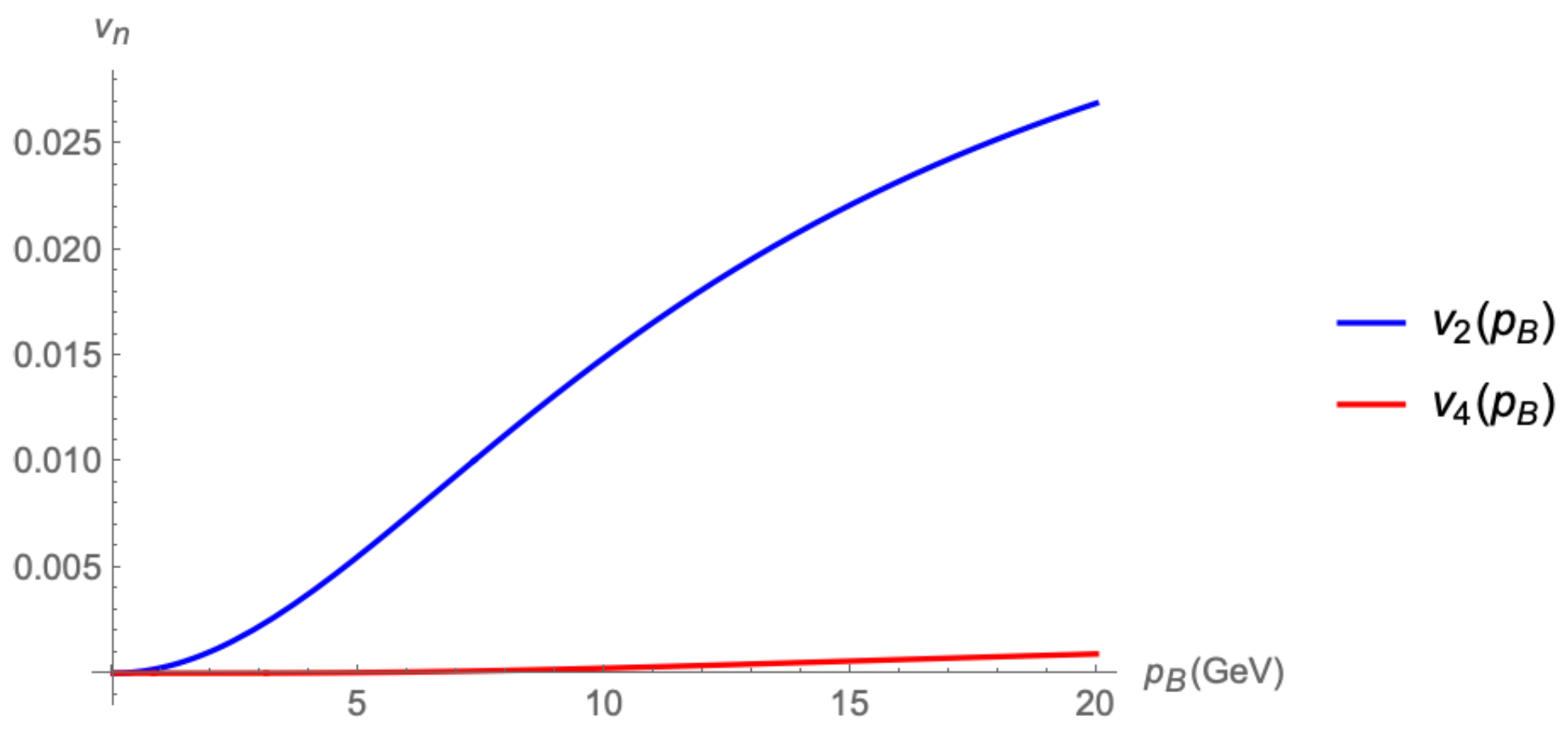1. Introduction
One of the main pillars underlying the physical interpretation of experimental data from ultrarelativistic collisions of heavy nuclei at RHIC or LHC is the collective flow of outgoing particles [
1]. In particular, the measured values of the Fourier coefficients
which quantify the azimuthal anisotropy of the transverse emission pattern, can be adequately reproduced in fluid-dynamical descriptions of the created fireball expansion, where
denotes the azimuth of the transverse momentum
of a particle and
the final-state
-distribution. The anisotropic flow coefficients
reflect the asymmetry of the initial transverse geometry of the overlap region of the colliding nuclei, quantified by eccentricities
and symmetry planes
.
The fluid-dynamical interpretation has been challenged by measurements of very similar coefficients
in “smaller systems”, as created in
or even high multiplicity
collisions, in which the creation of a collectively behaving medium was not expected. This has led to a renaissance of studies utilizing Boltzmann kinetic theory in the few collisions regime of small inverse Knudsen number
[
2,
3,
4,
5,
6]. In such approaches, the transverse momentum distribution entering Equation (
1) is actually the late time limit of a time-dependent distribution, which is itself related by a straightforward integral
to the central object of the kinetic theoretical framework, viz., the phase-space distribution
, whose evolution is governed by the Boltzmann equation. Note that Equation (
2) implicitly means that we only consider a two-dimensional setup hereafter—the generalization to a three-dimensional evolution with longitudinal boost invariance, as approximately holds around midrapidity, is quite straightforward.
While the kinetic-theoretical ansatz should certainly be relevant for the description of small and dilute systems, it may also hold for the larger ones created in
collisions, in the case of particles that barely interact with the rest of the fireball. Prominent examples are high-momentum partons that can quickly escape the system [
4], or color-neutral objects like heavy quarkonia generated in the initial stage provided the medium energy density is such that they remain bound. In these proceedings we briefly present the main elements of the description and apply it to an expanding system of massless “medium particles” (partons, labeled with a subscript p) and few massive particles (bottomonia, labeled with B), and demonstrate that even very few collisions in average per bottomonium lead to sizable anisotropic flow coefficients.
3. Results and Discussion—Bottomonium Anisotropic Flow in the Few Collisions Regime
Starting from the initial distributions (
3), we can compute the anisotropic flow coefficients
and
of bottomonia for the case of a collision kernel (
7) estimated with the free-streaming distributions. At a given transverse momentum (or, strictly speaking, transverse velocity, since this is the relevant kinematic quantity in the Boltzmann equation), we find
where we left aside unimportant numerical factors. We thus find that, to the considered level of approximation, both
and
are proportional to
, as reported in Ref. [
6]. By keeping distinct eccentricities for the initial distributions of bottomonia and massless partners, we exhibit specific scalings with
and
, which to our knowledge were never noted before: both contribute independently to
, which is linear in the eccentricities, and together to
, which is of quadratic order. Note that by deliberately omitting any “quadrangularity”
in the initial state, we miss the corresponding contributions to
[
6].
Setting now the average number of collisions per bottomonium to 1—which is physically absurd since none is surviving, but gives an upper limit on the signal—and taking both eccentricities to be equal to 0.5, we show in
Figure 1 the transverse momentum dependence of these anisotropic flow coefficients. In comparison to more elaborate computations [
7,
8], both
and
grow over the whole momentum range: in contrast to those models, we have no mechanism to “protect” the bottomonia from destruction, like the competition between their formation time—there is none in our model—and the time scale for the drop of the disassociation cross section, which we take to be constant.
Nonetheless the main result from our approach should be clear, namely that the considered mechanism efficiently produces sizeable anisotropic flow coefficients —although is at the limit of what is measurable. We admittedly enhanced the signals by going to the maximal acceptable value for and implementing a constant cross section, which means that the bottomonia feel the asymmetric shape—which naturally decreases with time—of the fireball along the whole evolution. On the other hand, by considering a free-streaming medium of massless constituents, we maximize its expansion rate and thus its rarefaction, which in turn works in the opposite direction, diminishing the signal.
An important feature of our approach is that we can improve the model in a rather systematic way, while still remaining at the semi-analytical level for the calculation of the anisotropic flow coefficients , at least as long as one keeps the assumption of a small number , which is anyway meaningful for bottomonia. Of course, a natural extension is to add the longitudinal space dimension. We can further distort the initial distributions, either including higher-order eccentricities, which will give rise to other anisotropic flow harmonics, or examining how differences between the distributions (symmetry planes, sizes) of the two particle species influence the final results. Another direction is to modify the ansatz for the distribution of partons directly in the collision integral, going for instance to an equilibrium distribution corresponding to a thermalized medium. As was mentioned above, we will also implement more realistic cross sections.
All in all, we can explore which ingredients allow for a better comparison to experimental data, at least for heavy quarkonia, for which the model should be helpful both in collisions and in smaller systems. Our present and subsequent findings need also be compared with numerical studies done in this direction, to support their calibration in the few collisions regime.




